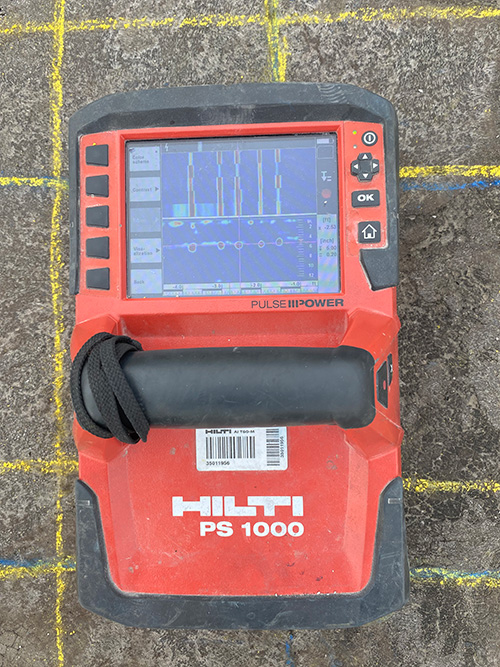Elevate Your Building And Construction Refine With the Strategic Insights of Concrete Scanning for Boosted Efficiency
In the realm of modern-day building practices, the pursuit for effectiveness and precision is extremely important. Accepting innovative modern technologies has actually become a cornerstone for accomplishing these goals. One such modern technology that has changed the building industry is concrete scanning. By using the strategic understandings given by concrete scanning, building professionals can unlock a world of enhanced performance and structured processes. The implications of integrating concrete scanning go far beyond surface-level advantages, providing a profound influence on task results.

Benefits of Concrete Scanning
Enhancing project efficiency and safety, concrete scanning provides a non-destructive technique for discovering concealed things within concrete structures. By using modern technologies such as ground-penetrating radar (GPR) and concrete x-ray imaging, construction groups can precisely situate rebar, post-tension wires, electric avenues, and other blockages before exploration, cutting, or coring into concrete.
The advantages of concrete scanning are many. Building and construction sites can be intricate environments, and understanding what exists below the surface area can avoid accidents and injuries.
In addition, concrete scanning promotes total job effectiveness by improving workflows and preventing rework. By recognizing possible issues early, groups can change their plans proactively, saving time and sources in the future. Fundamentally, the adoption of concrete scanning technologies is a critical financial investment that pays dividends in regards to safety, productivity, and cost-effectiveness.
Technology Combination for Effectiveness
Concrete scanning's ability to enhance operations and improve job effectiveness can be additional maximized with critical assimilation of innovative modern technologies. By including Building Info Modeling (BIM) software program into concrete scanning processes, building and construction groups can achieve a higher degree of precision and coordination. BIM permits the creation of 3D versions that offer in-depth insights into the task, making it possible for far better decision-making and minimizing the probability of errors. In addition, the assimilation of Augmented Truth (AR) modern technology with concrete scanning can enhance on-site visualization, permitting task supervisors and workers to overlay digital information onto the physical atmosphere in genuine time. This can promote a lot more precise positioning of components and enhance communication among staff member. The usage of drones for aerial surveys in conjunction with concrete scanning can expedite data collection and evaluation, making it possible for quicker decision-making and progression monitoring. Generally, the strategic combination of these technologies can significantly improve efficiency and efficiency in construction tasks.
Avoiding Costly Errors
How can meticulous attention to detail throughout concrete scanning processes help building groups in avoiding pricey errors? By using innovative scanning modern technologies such as Ground Passing Through Radar (GPR) and electromagnetic induction, see this here construction groups can precisely detect rebar, utilities, spaces, and various other blockages within concrete structures. In addition, concrete scanning assists in ensuring architectural honesty by recognizing weak points or issues in the concrete very early on, enabling for prompt repairs and modifications.
Enhancing Task Monitoring
Precise focus to information throughout concrete scanning refines not just assists in preventing costly errors but additionally lays a solid foundation for efficient project monitoring in construction ventures. more tips here By integrating concrete scanning technology right into task management strategies, building and construction groups can simplify process, enhance interaction, and make sure that jobs stay on track.
Concrete scanning offers useful understandings into the structural integrity of existing elements, allowing project managers to make informed choices pertaining to layout alterations or building sequences. This aggressive method reduces the danger of unexpected delays or remodel, eventually saving time and resources. Furthermore, the information obtained from concrete scanning can be incorporated into Structure Details Modeling (BIM) platforms, allowing real-time partnership and control among different stakeholders.
In addition, concrete scanning assists job supervisors identify possible threats or obstacles prior to they rise right into bigger issues, promoting a safer workplace for all included. With boosted exposure and accuracy provided by concrete scanning technology, task supervisors can successfully intend, check, and implement building and construction tasks with better effectiveness and self-confidence.
Optimizing Productivity
One crucial facet of optimizing performance is through the adoption of concrete scanning innovation. By making use of ground-penetrating radar (GPR) and various other scanning methods, building groups can accurately situate rebar, channels, and other subsurface aspects, decreasing the threat of find out pricey mistakes and delays during excavation and exploration.
Additionally, embracing Building Information Modeling (BIM) software application can significantly improve productivity by creating in-depth 3D designs that enhance project visualization and coordination among various professions. BIM permits better clash discovery, enabling problems to be determined and solved before building even begins, conserving time and resources in the lengthy run.
Implementing a lean building method, which concentrates on removing waste and enhancing efficiency throughout all task stages, is another effective strategy for taking full advantage of efficiency. By cultivating partnership, communication, and constant improvement, building and construction teams can work more cohesively towards achieving task goals in a streamlined and productive manner.
Verdict
To conclude, the strategic implementation of concrete scanning in the building process provides numerous advantages, consisting of raised performance, cost financial savings, improved task administration, and improved productivity. By integrating this technology, building groups can prevent costly mistakes, improve their operations, and optimize their general job outcome. Concrete scanning is a beneficial tool that can boost the construction process and result in more effective and lucrative outcomes.
